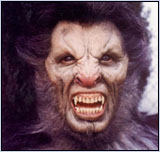How far removed are humans from their animal cousins? the disturbing truth is that, no matter what we would like to believe, we are all still beasts at hear. No matter what laws or morals we introduce to govern the instincts that nature has instilled within us, people are animals.
Is it any wonder, the, that animal-based monsters - frequently humans succumbing to their baser, animal nature - are such a part of our folklore, our nightmares, and our popular culture? Even today, human killers have their behaviour compared to the wild-blooded, savage nature of the wolf or to the cold-blooded, impassive brutality of the alligator.
 Throughout history, myth and legend have explored such ideas
and fears in the form of primal monsters, those that meld
humanity with animals. Perhaps the best known of these is the werewolf, or lycanthrope. The werewolf, however, is only
one form of shapeshifter in myth. There are legends and stories about humans who can transform into a wide variety
of animals, from house pets to sea creatures. That alteration of the human form to something considered "less" than
human and more bestial is the fundamental building block of all such mythical tales.
Throughout history, myth and legend have explored such ideas
and fears in the form of primal monsters, those that meld
humanity with animals. Perhaps the best known of these is the werewolf, or lycanthrope. The werewolf, however, is only
one form of shapeshifter in myth. There are legends and stories about humans who can transform into a wide variety
of animals, from house pets to sea creatures. That alteration of the human form to something considered "less" than
human and more bestial is the fundamental building block of all such mythical tales.
Just as Henry Jekyll did in Dr. Jekyll and Mr. Hyde, just as any of the werewolves or were-panthers or other were-creatures in folklore also felt, we feel, within us, the call of the wild, so to speak.
In the world of Buffy the Vampire Slayer, these ideas have been visited many times, most obviously in the case of Oz, one of our heroes, who also happens to be a werewolf.
The show's writers and producers stuck quite faithfully to werewolf folklore - a bite from an existing werewolf causes a human to transform into a wolf beneath the full moon, the efficacy of solver bullets against werewolfs, the lack of memory of the human who awakens after having been a wold - but it comes as no surprise that Joss Whedon tinkered with the formula just a little bit. Instead of becoming a wolf only on the night when the moon is at its fullest, werewolves on Buffy also transform the night before and the night after the full moon.
Those familiar with Whedon's penchant for horror comics, particularly those from the late '70s, might think this move inspired by the classic Marvel Comics series Werewolf by Night, which used the same time frame. The truth, however, is far more practical. Whedon didn't even remember tat element of the old comic-book series. Instead, it all came down, as it often does on a series of Buffy's quality, to storytelling.
Dean Batali, a season-two staff writer and one half of the team that scripted "Phases," the episode in which Oz became a werewolf explains:
"Of course, werewolves only come out on the full moon. But we knew if we did that, it would not work as a story. Otherwise the story would have had to take place all in on night, or over three months."
The simple solution: three night instead of one. Which, when you think about it, gives the werewolves of Buffy the Vampire Slayer a lot more time for carnage. Beyond that change, however, the writers and producers have kept quite faithful to the traditional werewolf folklore.
The series has also explored the concept of primals in other, varous and ingenious ways. In "The Pack," we were presented with animal spirits capable of possessing humans. "Teacher's Pet" introduced a giant praying mantis capable of taking on human form. In "Go Fish," we saw human/animal monsters created by science, a common theme in primal-based stories from pop culture.
Another episode that explored the Jekyll and Hyde theme was "Beauty and the Beasts," in which a student found a way to use a certain chemical formula to bring out the best within.
 "'Beauty and the Beasts' is the closest thing we've done to
a 'very special episode,'" notes supervising producer
Marti Noxon, who wrote the episode. That particular installment, she confirms, purposely addressed the fundamental
theme of Robert Louis Stevenson's The Strange Case of Dr. Jekyll and Mr. Hyde: the two natures of man - human
and animal. But the episode explored further.
"'Beauty and the Beasts' is the closest thing we've done to
a 'very special episode,'" notes supervising producer
Marti Noxon, who wrote the episode. That particular installment, she confirms, purposely addressed the fundamental
theme of Robert Louis Stevenson's The Strange Case of Dr. Jekyll and Mr. Hyde: the two natures of man - human
and animal. But the episode explored further.
"It also deals with the two natures of man in relation to young women," Noxon explains. "Young women have a tendency to be drawn to the darker side of man. To romanticize the bad boy. What is that about? And when does it become dangerous? When do you lose controle?"
That question speaks to the way in which Buffy, Willow, and the others draw the line between werewolves and vampires. Werewolves are only monsters three nights out of a month. To kill the monster, you must also kill the human, something none of them was willing to do in Oz's case. Because he was inherently good, he fought the beast within. He was willing to be caged, to do whatever was necessary to control his curse. They even saved Oz from a werewolf hunter. But the line was more finely drawnlater, when a second werewolf, Veruca, was introduced. Veruca embraced the beast within, and so became a monster full time, rather than only when in wolf form.
Though not a werewolf, the "Beauty and the Beasts" character, Pete, embraced the monster just as Veruca would do later. "Each woman in ["Beauty and the Beasts"] was trying to figure out where her man fell in that continuum," Marti Noxon says. "Oz is really bad three night a month. Angel was really bad, but is he bad now? Which one of them is seeking out something destructive, and which of these relationships just have an element that is in all relationships? There is a side to men and to women that is more animal. People think it was our domestic-abuse episode. But it was more about women's attraction to the alpha dog and when relationships are just bad [as opposed to] when they're sick or dangerous."
"The episode where Oz leaves [season four's "Wild at Heart"] is a sister episode," Noxon adds. "What is our basic animal nature? How much of that should be fulfilled, and how much do we have to resist and say no, that's a dangerous impulse? Many of the problems we have between men and women are based on the fact that we deny a lot of these impulses and blame other things."
"The question of how much of me is animal and how much is man and how to control that is a big reason why Willow and Oz wnd up breaking up. At that age, kids are really wrestling with that. To stay faithful to one person from the time you're eighteen is a tall order. A lot of men will say, I can't help it, it's the dog in me. There is truth in that."
 Thus, Oz departed. Despite the willingness of his friends to accept
that as a werewolf he was two beings - human and animal
- Veruca's influence had caused hjim to wonder if that were true, or he was actually something in between. When Oz returned
for a single episode ("New Moon Rising") viewers learned that a combination of herbs and meditation techniques had given
him some control over his transformation. But Oz still struggles with his dual nature.
Thus, Oz departed. Despite the willingness of his friends to accept
that as a werewolf he was two beings - human and animal
- Veruca's influence had caused hjim to wonder if that were true, or he was actually something in between. When Oz returned
for a single episode ("New Moon Rising") viewers learned that a combination of herbs and meditation techniques had given
him some control over his transformation. But Oz still struggles with his dual nature.
Once again, a subject of our nightmares, of our ancient folklore, and of art, literature, film and television: is our primal nature stronger than our human rationality?
Are we men and women... or are we monsters?